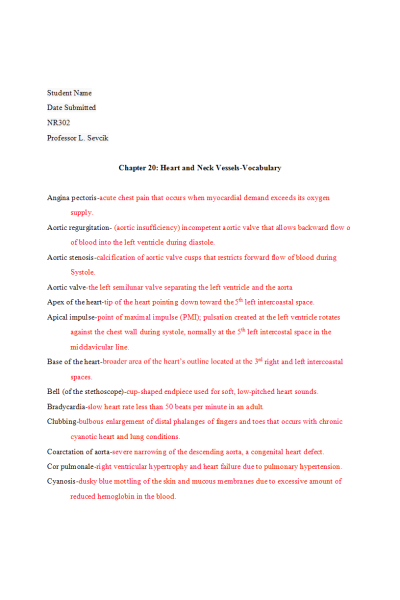NR 302 Week 6 Assignment Chapter 20; Heart and Neck Vessels-Vocabulary & Chapter 20 Heart and Neck Vessels-Workbook
-
$25.00
| Institution | NR 302 Health Assessment I |
| Contributor | Irina |
Chapter 20: Heart and Neck Vessels-Vocabulary
Angina pectoris
Aortic regurgitation
Aortic stenosis
Aortic valve
Apex of the heart
Apical impulse
Base of the heart
Bell (of the stethoscope)
Bradycardia
Clubbing
Coarctation of aorta
Cor pulmonale
Cyanosis
Diaphragm (of the stethoscope)
Diastole
Dyspnea
Edema
Erb’s point
First heart sound (S1)
Fourth heart sound(S4)
Gallop rhythm
Itching.
Left ventricular hypertrophy (LVH)
Midclavicular line (MCL)
Mitral regurgitation
Mitral stenosis
Mitral valve
Palpation
Paradoxical splitting
Pericardial friction rub
Physiologic splitting
Precordium.
Pulmonic regurgitation
Pulmonic stenosis
Pulmonic valve
Second heart sound (S2
Summation gallop
Syncope
Systole
Tachycardia
Third heart sound (S1
Thrill
Tricuspid valve
Chapter 20: Heart and Neck Vessels-Workbook
- Question: Define the apical impulse and describe its normal location, size, and duration. Which abnormal conditions may affect the location of the apical impulse?
- Question: Explain the mechanism producing normal first and second heart sounds
- Question: Describe the effect of respiration on the heart sounds.
- Question: Describe the characteristics of the first heart sound and its intensity at the apex of the heart and at the base.
- Question: Describe the characteristics of the second heart sound and its intensity at the apex of the heart and at the base.
- Question: Explain the physiologic mechanism for normal splitting of S2 in the pulmonic valve area.
- Question: Define the third heart sound. When in the cardiac cycle does it occur? Describe its intensity, quality, location in which it is heard, and method of auscultation
- Question: Differentiate a physiologic S3 from a pathologic S3.
- Question: Define the fourth heart sound. When in the cardiac cycle does it occur? Describe its intensity, quality, location in which it is heard, and method of auscultation.
- Question: Explain the position of the valves during the cardiac cycle in diastole, isometric contraction, systole, and isometric relaxation.
- Question: Define venous pressure and jugular venous pulse.
- Question: Differentiate between carotid artery pulsation and jugular vein pulsation.
- Question: List the major risk factors for heart disease and stroke as identified in this text.
- Question: Define bruit and discuss what it indicates.
- Question: State 4 guidelines to distinguish S1 from S2.
- Question: Define pulse deficit and discuss what it indicates.
- Question: Define preload and afterload.
- Question: List the characteristics to explore when you hear a murmur, including the grading scale of murmurs.
- Question: Discuss the characteristics of an innocent or functional murmur.
| Instituition / Term | |
| Term | Uploaded 2023 |
| Institution | NR 302 Health Assessment I |
| Contributor | Irina |














